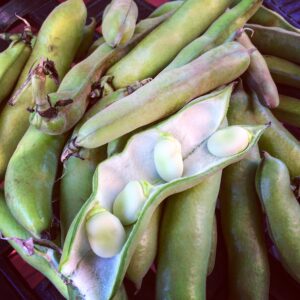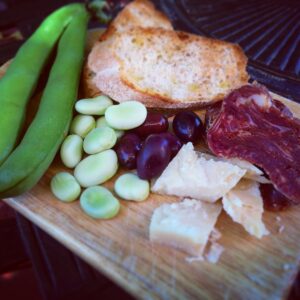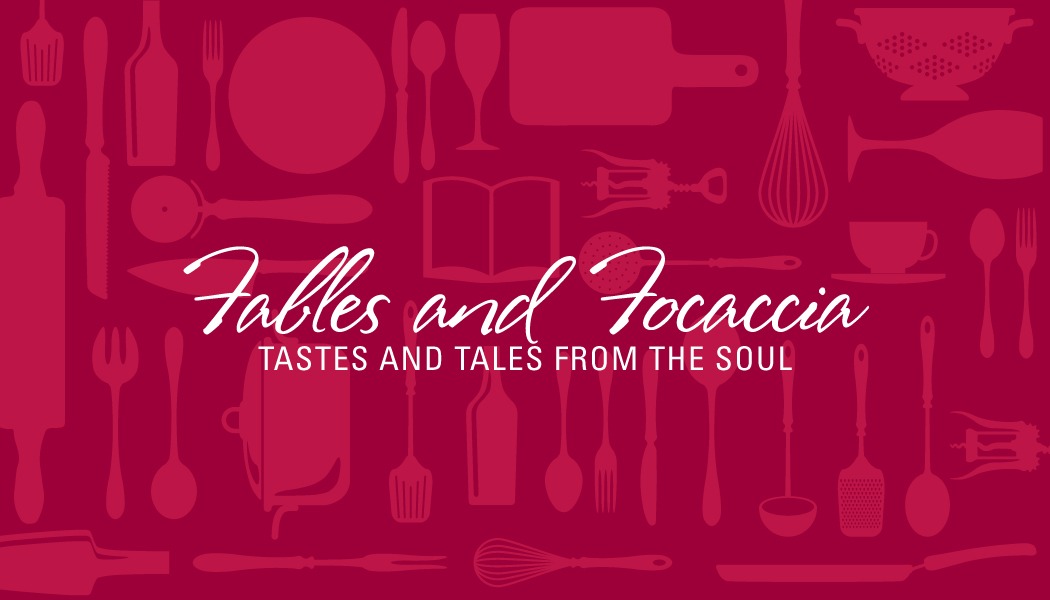Guest Blog Written By: Jenny Arena from Fables and Focaccia
The Fab Fava
The fava bean, a legume that here in North America, is often overlooked and underestimated. While Hannibal Lector gave the broad bean 15 minutes of fame when he uttered those now infamous words in Silence of the Lambs, fava beans should be regarded as much more than a side dish to a cannibal’s meal.
Fava beans, are members of the pea family, and are one of the oldest plants in cultivation. Also known as pigeon beans, horse beans and Windsor beans, they were a staple in ancient Mediterranean civilization. Not only did they form part of the diet of the ancient Greeks and Romans but they were also used in voting. White and black fava beans were used to cast yes and no votes.
 Fava beans have a distinct earthy flavor and creamy texture. They can be found in many popular summer dishes in Mediterranean cuisine. The seasonal bean is often celebrated and enjoyed in soups, pastas, risottos and salads. They can be grilled; ground into purees; fried to produce a crunchy snack; steamed and served with olive oil, salt and lemon; or merely eaten straight out of their soft green pods alongside Percorino or other local cheeses, salami and olives. When harvested young, even their leaves can be enjoyed either raw, or cooked in the same manner as spinach.
Fava beans have a distinct earthy flavor and creamy texture. They can be found in many popular summer dishes in Mediterranean cuisine. The seasonal bean is often celebrated and enjoyed in soups, pastas, risottos and salads. They can be grilled; ground into purees; fried to produce a crunchy snack; steamed and served with olive oil, salt and lemon; or merely eaten straight out of their soft green pods alongside Percorino or other local cheeses, salami and olives. When harvested young, even their leaves can be enjoyed either raw, or cooked in the same manner as spinach.
The little green gems are deliciously versatile and believed to bring good fortune. In some parts of Italy, people carry a broad bean for good luck, believing that if one carries a fava bean, they will never be without the essentials in life. It is the fava bean crop in fact that is said to have saved the Sicilian population from starvation during a terrible drought. Because of this the beans are traditional on many St. Joseph’s Day altars as an offering of thanks to patron saint of Sicily.
As they are a spring and summer crop they are typically celebrated alongside other spring greens such as peas and artichokes. The beans are typically sown on All Souls Day, November 2nd and are known as fave dei morti and cakes made in the shape of them (but not from them) are commonly eaten.
 Growing up, fresh fava beans were a clear sign and taste of summer in my household. My father would make a trip to the local farm and bring home abundant baskets of broad beans which we would then pluck from the cotton interior of their pods and savor immediately. The bitter crunch of the raw beans made a wonderful lunch alongside salty Parmigiano or ricotta affumicata from Calabria, briny green olives, homemade soppressata, crusty Italian bread and a glass of vino.
Growing up, fresh fava beans were a clear sign and taste of summer in my household. My father would make a trip to the local farm and bring home abundant baskets of broad beans which we would then pluck from the cotton interior of their pods and savor immediately. The bitter crunch of the raw beans made a wonderful lunch alongside salty Parmigiano or ricotta affumicata from Calabria, briny green olives, homemade soppressata, crusty Italian bread and a glass of vino.
After our peasant feast we would then proceed to shell the remaining beans along with fresh peas and combine them together to create a sensational summer stew, to be spooned over conchiglietti for an earthy and hearty pasta dinner.
Conchiglietti con Fave e Piselli
Ingredients:
500 grams of fresh fava beans
500 grams of fresh peas
660 ml jar passata di pomodoro
1 large onion chopped
1 cup of water
3-4 potatoes peeled and cubed
Salt and pepper to taste
Cubed pancetta or capicollo for flavor (optional)
Preparation:
Remove the fresh fava beans and peas from their pods and rinse thoroughly. Place the beans along with the remaining ingredients in a large sauce pot and simmer over medium heat for 1-1 ½ hours until you get a rich bean stew. Cook the pasta according to directions then enjoy topped with a generous portion of the fava bean and pea stew. This bean stew can also be enjoyed on its own with some crusty bread or a side dish.
Buon Appetito!
For more from Fables and Focaccia be sure to check them out online
“LIKE” them on facebook and “FOLLOW” them on instagram, twitter and pinterest!

